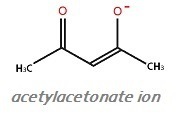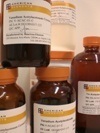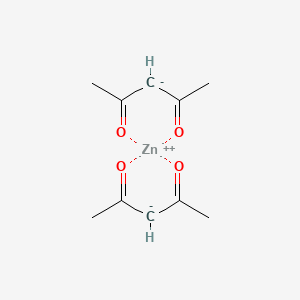SECTION 1. IDENTIFICATION
Product Name: Zinc Acetylacetonate
Product Number: All applicable American Elements product codes, e.g. ZN-ACAC-02-C.AHYD
, ZN-ACAC-03-C.AHYD
, ZN-ACAC-04-C.AHYD
, ZN-ACAC-05-C.AHYD
CAS #: 14024-63-6
Relevant identified uses of the substance: Scientific research and development
Supplier details:
American Elements
10884 Weyburn Ave.
Los Angeles, CA 90024
Tel: +1 310-208-0551
Fax: +1 310-208-0351
Emergency telephone number:
Domestic, North America: +1 800-424-9300
International: +1 703-527-3887
SECTION 2. HAZARDS IDENTIFICATION
Classification
This chemical is considered hazardous by the 2012 OSHA Hazard Communication Standard (29 CFR 1910.1200)
Label Elements
Signal Word
Warning
Hazard Statements
Harmful if swallowed
Causes skin irritation
Causes serious eye irritation
May cause respiratory irritation

Precautionary Statements
Prevention
Wash face, hands and any exposed skin thoroughly after handling
Do not eat, drink or smoke when using this product
Wear protective gloves/protective clothing/eye protection/face protection
Avoid breathing dust/fume/gas/mist/vapors/spray
Use only outdoors or in a well-ventilated area
Inhalation
IF INHALED: Remove victim to fresh air and keep at rest in a position comfortable for breathing
Call a POISON CENTER or doctor/physician if you feel unwell
Skin
IF ON SKIN: Wash with plenty of soap and water
If skin irritation occurs: Get medical advice/attention
Take off contaminated clothing and wash before reuse
Eyes
IF IN EYES: Rinse cautiously with water for several minutes. Remove contact lenses, if present and easy to do. Continue rinsing
If eye irritation persists: Get medical advice/attention
Ingestion
IF SWALLOWED: Call a POISON CENTER or doctor/physician if you feel unwell
Rinse mouth
Storage
Store in a well-ventilated place. Keep container tightly closed
Store locked up
Disposal
Dispose of contents/container to an approved waste disposal plant
Hazards not otherwise classified (HNOC)
May form combustible dust concentrations in air
SECTION 3. COMPOSITION/INFORMATION ON INGREDIENTS
Component CAS-No Weight %
Zinc, bis(2,4-pentanedionato-O,O')-, (T-4)- 14024-63-6 >95
SECTION 4. FIRST AID MEASURES
Eye Contact Rinse immediately with plenty of water, also under the eyelids, for at least 15 minutes.
Obtain medical attention.
Skin Contact Wash off immediately with plenty of water for at least 15 minutes. Obtain medical attention.
Inhalation Move to fresh air. If breathing is difficult, give oxygen. If not breathing, give artificial
respiration. Do not use mouth-to-mouth resuscitation if victim ingested or inhaled the
substance; induce artificial respiration with a respiratory medical device. Obtain medical
attention.
Ingestion Do not induce vomiting. Call a physician or Poison Control Center immediately.
Most important symptoms/effects No data available.
Notes to Physician Treat symptomatically
SECTION 5. FIREFIGHTING MEASURES
Suitable Extinguishing Media
Water spray. Carbon dioxide (CO 2). Dry chemical. chemical foam.
Unsuitable Extinguishing Media No data available
Flash Point No data available
Method - No data available
Autoignition Temperature 580 °C / 1076 °F
Explosion Limits
Upper No data available
Lower No data available
Sensitivity to Mechanical Impact No data available
Sensitivity to Static Discharge No data available
Specific Hazards Arising from the Chemical
Fine dust dispersed in air may ignite.
Hazardous Combustion Products
Carbon monoxide (CO) Carbon dioxide (CO2)
Protective Equipment and Precautions for Firefighters
As in any fire, wear self-contained breathing apparatus pressure-demand, MSHA/NIOSH (approved or equivalent) and full
protective gear.
NFPA
Health
2
Flammability
1
Instability
0
Physical hazards
N/A
SECTION 6. ACCIDENTAL RELEASE MEASURES
Personal Precautions Ensure adequate ventilation. Use personal protective equipment. Avoid dust formation.
Environmental Precautions Should not be released into the environment.
Methods for Containment and Clean
Up
Sweep up or vacuum up spillage and collect in suitable container for disposal. Do not let
this chemical enter the environment. Avoid dust formation.
SECTION 7. HANDLING AND STORAGE
Handling Ensure adequate ventilation. Avoid contact with skin and eyes. Do not breathe dust. Do not
ingest. Minimize dust generation and accumulation. Wash hands before breaks and
immediately after handling the product.
Storage Keep in a dry, cool and well-ventilated place. Keep container tightly closed.
SECTION 8. EXPOSURE CONTROLS/PERSONAL PROTECTION
Exposure Guidelines This product does not contain any hazardous materials with occupational exposure limits
established by the region specific regulatory bodies.
Engineering Measures Ensure adequate ventilation, especially in confined areas. Ensure that eyewash stations
and safety showers are close to the workstation location.
Personal Protective Equipment
Eye/face Protection Wear appropriate protective eyeglasses or chemical safety goggles as described by
OSHA's eye and face protection regulations in 29 CFR 1910.133 or European Standard
EN166.
Skin and body protection Wear appropriate protective gloves and clothing to prevent skin exposure.
Respiratory Protection
No protective equipment is needed under normal use conditions.
Hygiene Measures Handle in accordance with good industrial hygiene and safety practice.
SECTION 9. PHYSICAL AND CHEMICAL PROPERTIES
Physical State Powder Solid
Appearance Off-white
Odor No data available
Odor Threshold No data available
pH 10 4 g/L aq.sol
Melting Point/Range 124 - 126 °C / 255.2 - 258.8 °F
Boiling Point/Range 129 - 131 °C / 264.2 - 267.8 °F @ 10 mmHg
Flash Point No data available
Evaporation Rate N/A
Flammability (solid,gas) No data available
Flammability or explosive limits
Upper No data available
Lower No data available
Vapor Pressure No data available
Vapor Density N/A
Relative Density No data available
Solubility No data available
Partition coefficient; n-octanol/water No data available
Autoignition Temperature 580 °C / 1076 °F
Decomposition Temperature > 170°C
Viscosity N/A
Molecular Formula C10 H14 O4 Zn
Molecular Weight 263.59
SECTION 10. STABILITY AND REACTIVITY
Reactive Hazard None known, based on information available
Stability Stable under normal conditions.
Conditions to Avoid Avoid dust formation. Incompatible products. Exposure to moist air or water.
Incompatible Materials Acids, Strong oxidizing agents, Strong bases
Hazardous Decomposition Products Carbon monoxide (CO), Carbon dioxide (CO2)
Hazardous Polymerization No data available.
Hazardous Reactions None under normal processing.
SECTION 11. TOXICOLOGICAL INFORMATION
Acute Toxicity
Product Information
Component Information
Toxicologically Synergistic
Products
No data available
Delayed and immediate effects as well as chronic effects from short and long-term exposure
Irritation Irritating to eyes, respiratory system and skin
Sensitization No data available
Carcinogenicity The table below indicates whether each agency has listed any ingredient as a carcinogen.
Component CAS-No IARC NTP ACGIH OSHA Mexico
Zinc,
bis(2,4-pentanedionato
-O,O')-, (T-4)-
14024-63-6 Not listed Not listed Not listed Not listed Not listed
Mutagenic Effects No data available
Reproductive Effects
No data available.
Developmental Effects No data available.
Teratogenicity No data available.
STOT - single exposure Respiratory system
STOT - repeated exposure None known
Aspiration hazard No data available
Symptoms / effects,both acute and
delayed
No data available
Endocrine Disruptor Information No data available
Other Adverse Effects The toxicological properties have not been fully investigated. See actual entry in RTECS for
complete information.
SECTION 12. ECOLOGICAL INFORMATION
Ecotoxicity
Do not empty into drains.
Persistence and Degradability Soluble in water Persistence is unlikely based on information available.
Bioaccumulation/ Accumulation No data available.
Mobility Will likely be mobile in the environment due to its water solubility.
SECTION 13. DISPOSAL CONSIDERATIONS
Waste Disposal Methods Chemical waste generators must determine whether a discarded chemical is classified as a
hazardous waste. Chemical waste generators must also consult local, regional, and
national hazardous waste regulations to ensure complete and accurate classification.
SECTION 14. TRANSPORT INFORMATION
DOT Not regulated
TDG Not regulated
IATA Not regulated
IMDG/IMO Not regulated
SECTION 15. REGULATORY INFORMATION
International Inventories
Component TSCA DSL NDSL EINECS ELINCS NLP PICCS ENCS AICS IECSC KECL
Zinc,
bis(2,4-pentanedionato-O,O')
-, (T-4)-
X X - 237-860-3 - X X X X X
Legend:
X - Listed
E - Indicates a substance that is the subject of a Section 5(e) Consent order under TSCA.
F - Indicates a substance that is the subject of a Section 5(f) Rule under TSCA.
N - Indicates a polymeric substance containing no free-radical initiator in its inventory name but is considered to cover the designated
polymer made with any free-radical initiator regardless of the amount used.
P - Indicates a commenced PMN substance
R - Indicates a substance that is the subject of a Section 6 risk management rule under TSCA.
S - Indicates a substance that is identified in a proposed or final Significant New Use Rule
T - Indicates a substance that is the subject of a Section 4 test rule under TSCA.
XU - Indicates a substance exempt from reporting under the Inventory Update Rule, i.e. Partial Updating of the TSCA Inventory Data Base
Production and Site Reports (40 CFR 710(B).
Y1 - Indicates an exempt polymer that has a number-average molecular weight of 1,000 or greater.
Y2 - Indicates an exempt polymer that is a polyester and is made only from reactants included in a specified list of low concern reactants
that comprises one of the eligibility criteria for the exemption rule.
U.S. Federal Regulations
TSCA 12(b) N/A
SARA 313 N/A
Component CAS-No Weight % SARA 313 - Threshold
Values %
Zinc, bis(2,4-pentanedionato-O,O')-, (T-4)- 14024-63-6 >95 1.0
SARA 311/312 Hazardous Categorization
Acute Health Hazard Yes
Chronic Health Hazard No
Fire Hazard Yes
Sudden Release of Pressure Hazard No
Reactive Hazard No
Clean Water Act N/A
Component CWA - Hazardous
Substances
CWA - Reportable
Quantities
CWA - Toxic Pollutants CWA - Priority Pollutants
Zinc,
bis(2,4-pentanedionato-O,O')-,
(T-4)-
- - X -
Clean Air Act N/A
OSHA Occupational Safety and Health Administration
N/A
CERCLA
N/A
California Proposition 65 This product does not contain any Proposition 65 chemicals
State Right-to-Know N/A
Component Massachusetts New Jersey Pennsylvania Illinois Rhode Island
Zinc,
bis(2,4-pentanedionato-O
,O')-, (T-4)-
- X X - -
U.S. Department of Transportation
Reportable Quantity (RQ): N
DOT Marine Pollutant N
DOT Severe Marine Pollutant N
U.S. Department of Homeland Security
This product does not contain any DHS chemicals.
Other International Regulations
Mexico - Grade No data available
Canada
This product has been classified in accordance with the hazard criteria of the Controlled Products Regulations (CPR) and
the MSDS contains all the information required by the CPR
WHMIS Hazard Class D1B Toxic materials
D2B Toxic materials
SECTION 16. OTHER INFORMATION
Safety Data Sheet according to Regulation (EC) No. 1907/2006 (REACH). The above information is believed to be correct but does not purport to be all inclusive and shall be used only as a guide. The information in this document is based on the present state of our knowledge and is applicable to the product with regard to appropriate safety precautions. It does not represent any guarantee of the properties of the product. American Elements shall not be held liable for any damage resulting from handling or from contact with the above product. See reverse side of invoice or packing slip for additional terms and conditions of sale. COPYRIGHT 1997-2022 AMERICAN ELEMENTS. LICENSED GRANTED TO MAKE UNLIMITED PAPER COPIES FOR INTERNAL USE ONLY.
 The zinc atom has a radius of 134 pm and a Van der Waals radius of 210 pm. Zinc was discovered by Indian metallurgists prior to 1000 BC and first recognized as a unique element by Rasaratna Samuccaya in 800. Zinc was first isolated by Andreas Marggraf in 1746. In its elemental form, zinc has a silver-gray appearance. It is brittle at ordinary temperatures but malleable at 100 °C to 150 °C.
The zinc atom has a radius of 134 pm and a Van der Waals radius of 210 pm. Zinc was discovered by Indian metallurgists prior to 1000 BC and first recognized as a unique element by Rasaratna Samuccaya in 800. Zinc was first isolated by Andreas Marggraf in 1746. In its elemental form, zinc has a silver-gray appearance. It is brittle at ordinary temperatures but malleable at 100 °C to 150 °C. It is a fair conductor of electricity, and burns in air at high red producing white clouds of the oxide. Zinc is mined from sulfidic ore deposits. It is the 24th most abundant element in the earth's crust and the fourth most common metal in use (after iron, aluminum, and copper). The name zinc originates from the German word "zin," meaning tin.
It is a fair conductor of electricity, and burns in air at high red producing white clouds of the oxide. Zinc is mined from sulfidic ore deposits. It is the 24th most abundant element in the earth's crust and the fourth most common metal in use (after iron, aluminum, and copper). The name zinc originates from the German word "zin," meaning tin.
 compounds). The high purity
compounds). The high purity 
